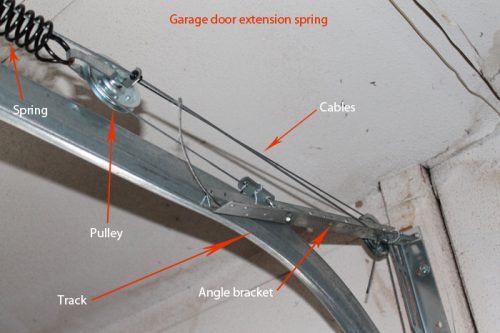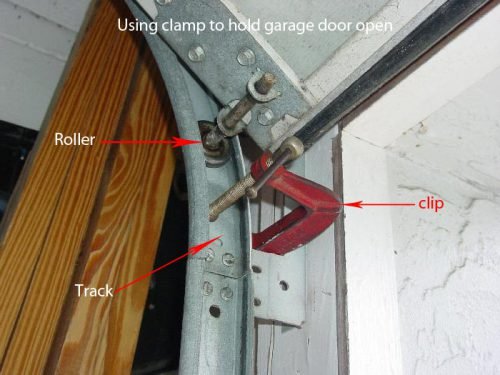You will need the following tools for this work: a ladder, two C-clamps or locking pliers, and an adjustable wrench. It is also reasonable to protect your eyes with safety glasses, use gloves and a hard hat.
The way you adjust the springs depends on the type of issue.
You need to increase the tension in case the door can be lifted only with difficulty or if it closes faster than it should. You need to lower the tension in case the door can be closed only with difficulty or it opens faster than it should. Also, lowering the tension helps if the door cannot be closed fully.
If you notice a gap on one side, it means that one of the springs is putting more force on the door than the other. You will have to adjust the tension on that side.
Secure the door in place
Before you start actually adjusting the door, push it up as far as possible. Springs should be relaxed. Insert a C-clamp in the track below the roller on either side. Alternatively, you may use two locking pliers for this purpose.
This step protects you. If the door is secured in this way, it will not fall while you are working.
Adjust the tension
There are two ways you can change the tension on the springs. You either move the hook holding the cable or loosen the clamp on the cable and make the cable shorter or longer. Typically, you first move the hook, then you make a minor adjustment by changing the length of the cable.
To start with, find the big hook that is used to attach the spring to the track hanger. Take an adjustable wrench and remove the nut from the track hanger. It will give you a chance to change the position of the hook that holds the cable.
If you need to decrease the tension on the springs, start by moving the hook one hole away from the framing. It will reduce the length of the spring when it is under tension. Perform the same step on the other side. Test the door to see whether it is working properly and whether the gap has disappeared. If not, open the door to the full, secure it again, then move the hook once more.
If your garage door is hard to open, you most likely need to reduce the tension. To do this, move the hook in the opposite direction, toward the door framing. Perform the same step on the other side and test the door.
Always move the hooks on both the springs equally. The only exception to this rule is the door that is out of balance. You will recognize it by a gap on one side. You will have to make the adjustment on the side with the gap. Hook the spring onto a lower hole and test the door.
Hook the spring one more hole lower or higher until the door is closing properly.
Change the length of the cable
This step might be necessary if a finer adjustment than the holes are allowing for is required. Find a clip on the cable. There is a knot or a clamp in the place where the cable is connected to the hook. Loosen it and make the cable longer or shorter to reduce or increase the tension.
If your door is closing properly, your work is done. Now you can pull on the emergency cord and plug in the automatic door opener.


